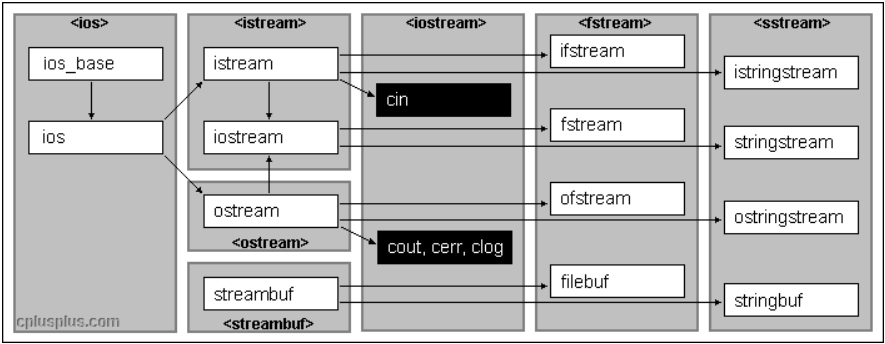本文主要用于探讨使用C++来进行文件读写操作。
在C++中,所有的输入输出操作大部分都继承自 ios_base 基类,详细的继承体系如下图所示

fstream的使用
在fstream类中,成员函数open()实现打开文件的操作,从而将数据流和文件进行关联,通过ofstream,ifstream,fstream对象进行对文件的读写操作,同时在打开文件时,可以指定打开的模式,如读、写或者读写,可选模式如下
| mode | detail |
|---|---|
| ios::in | 为输入(读)而打开文件 |
| ios::out | 为输出(写)而打开文件 |
| ios::ate | 初始位置:文件尾 |
| ios::app | 所有输出附加在文件末尾 |
| ios::trunc | 如果文件已存在则先删除该文件 |
| ios::binary | 二进制方式 |
open的定义方式
void open(const wchar_t *_Filename,
ios_base::openmode mode= ios_base::in | ios_base::out;
void open(const wchar_t *_Filename,
ios_base::openmode mode= ios_base::in | ios_base::out,
int prot = ios_base::_Openprot);
其中,filename表示操作文件名,mode表示打开文件的方式,prot表示打开文件的属性。在打开文件时,在stream类的构造函数中调用open()函数都有自己默认的操作方式
ofstream out("...", ios::out);
ifstream in("...", ios::in);
fstream foi("...", ios::in|ios::out);
使用write()和read()函数进行文件读写
int main(){
string file_path = "test.txt";
char info[] = "hello fan";
char buffer[256];
ofstream out(file_path, ios::binary);
if(out.is_open()){
out.write(info, sizeof(info));
out.close();
}
ifstream in(file_path, ios::binary);
if(in.is_open()){
while(!in.eof()){
in.read(buffer, 100);
cout << buffer << endl;
}
in.close();
}
return 0;
}
// out
/*
hello fan
*/
ofstream重载了 <<操作符可用来向文件输出数据,ifstream重载了>>操作符,可用来读入数据。
#include <iostream>
#include<fstream>
#include<string>
using namespace std;
int main(){
string file_path = "test.txt";
char buffer[256];
ofstream out(file_path);
if(out.is_open()){
out << "hello ";
out << "fan";
out.close();
}
ifstream in(file_path);
if(in.is_open()){
while(!in.eof()){
in.getline(buffer, 100);
cout << buffer << endl;
}
}
return 0;
}
// hello fan
在上述代码中,使用is_open()函数,用来判断文件是否正常打开,eof()函数用来判断是否读到文件末尾。
除了这些以外,还有一些验证流的状态的成员函数(所有都返回bool型返回值):
-
bad()
如果在读写过程中出错,返回 true 。例如:当我们要对一个不是打开为写状态的文件进行写入时,或者我们要写入的设备没有剩余空间的时候。 -
fail()
除了与bad() 同样的情况下会返回 true 以外,加上格式错误时也返回true ,例如当想要读入一个整数,而获得了一个字母的时候。 -
good()
这是最通用的:如果调用以上任何一个函数返回true 的话,此函数返回 false 。
为了能够更为方便地对文件进行操作,还需要能够判断我们读文件读到了哪里,使用函数tellg/tellp 用于提取当前文件指针的位置,使用函数 seekg/seekp 来将文件指针移到某处
-
tellg() 和 tellp()
这两个成员函数不用传入参数,返回pos_type 类型的值(根据ANSI-C++ 标准) ,就是一个整数,代表当前get 流指针的位置 (用tellg) 或 put 流指针的位置(用tellp). -
seekg() 和seekp()
这对函数分别用来改变流指针get 和put的位置。两个函数都被重载为两种不同的原型:
seekg ( pos_type position );
seekp ( pos_type position );
使用这个原型,流指针被改变为指向从文件开始计算的一个绝对位置。要求传入的参数类型与函数 tellg 和tellp 的返回值类型相同。
seekg ( off_type offset, seekdir direction );
seekp ( off_type offset, seekdir direction );
使用这个原型可以指定由参数direction决定的一个具体的指针开始计算的一个位移(offset)。它可以是:
| type | detail |
|---|---|
| ios::beg | 从流开始位置计算的位移 |
| ios::cur | 从流指针当前位置开始计算的位移 |
| ios::end | 从流末尾处开始计算的位移 |
示例
int main(){
string file_path = "test.txt";
char buffer[256];
ifstream in(file_path);
if(in.is_open()){
auto site = in.tellg();
in.seekg(site+6, ios::cur);
while(!in.eof()){
in.getline(buffer, 100);
cout << buffer << endl;
}
}
return 0;
}
上述文件中数据为 "hello fan",输出为 "fan",因为开始时,文件指针指向文件开头,使用tellg()函数获取文件指针位置,然后使用seekg()函数将文件指针后移6个字符,因此读取结果为 "fan"。
简单文件读写示例
#include <iostream>
#include<fstream>
#include<string>
using namespace std;
int choose_mod(){
int f = 0;
cout << "----Easy file read and write----" << endl;
cout << "Please choose write or read file" << endl;
cout << "Enter 1, read file" << endl;
cout << "Enter 2, write file" << endl;
cout << "Enter 3, exit" << endl;
cout << "--------------------------------" << endl;
cin >> f;
while(f != 1 && f != 2 && f != 3){
cout << "Please choose 1 or 2 or 3" << endl;
cin >> f;
}
}
int main(){
string file_name = "test.txt";
int mod = choose_mod();
char buffer[256];
ifstream in;
ofstream out;
string tmp;
while(mod != 3){
if(mod == 1){
in.open(file_name);
if(in.is_open()){
while(!in.eof()){
in.getline(buffer, 100);
cout << buffer << endl;
}
in.close();
}
}else{
out.open(file_name, ios::app);
if(out.is_open()){
cout << "Please enter string, Enter quit end" << endl;
tmp = "";
while(true){
getline(cin, tmp);
if(tmp == "quit") break;
out << tmp << "
";
}
out.close();
}
}
mod = choose_mod();
}
cout << "Quit" << endl;
return 0;
}